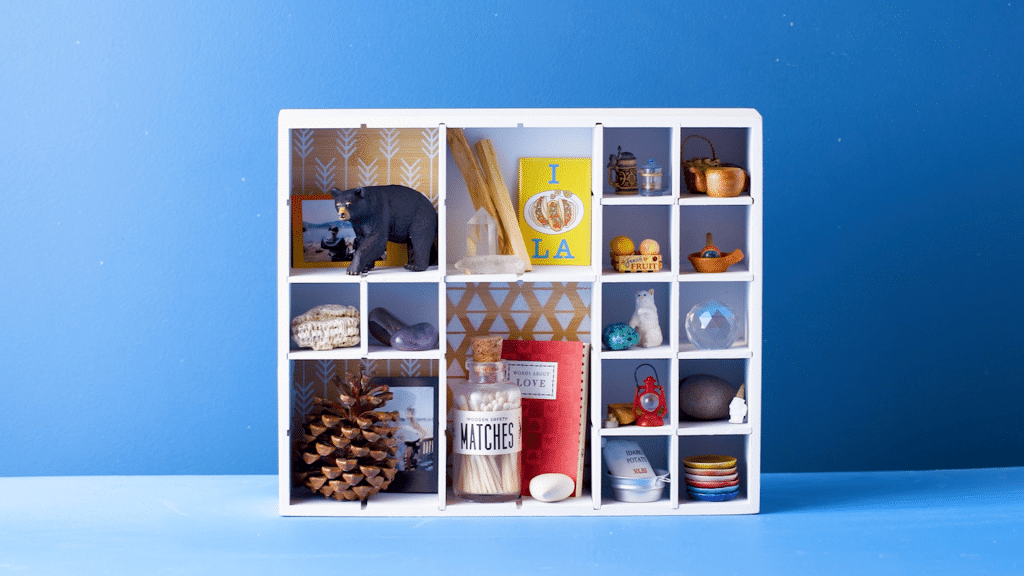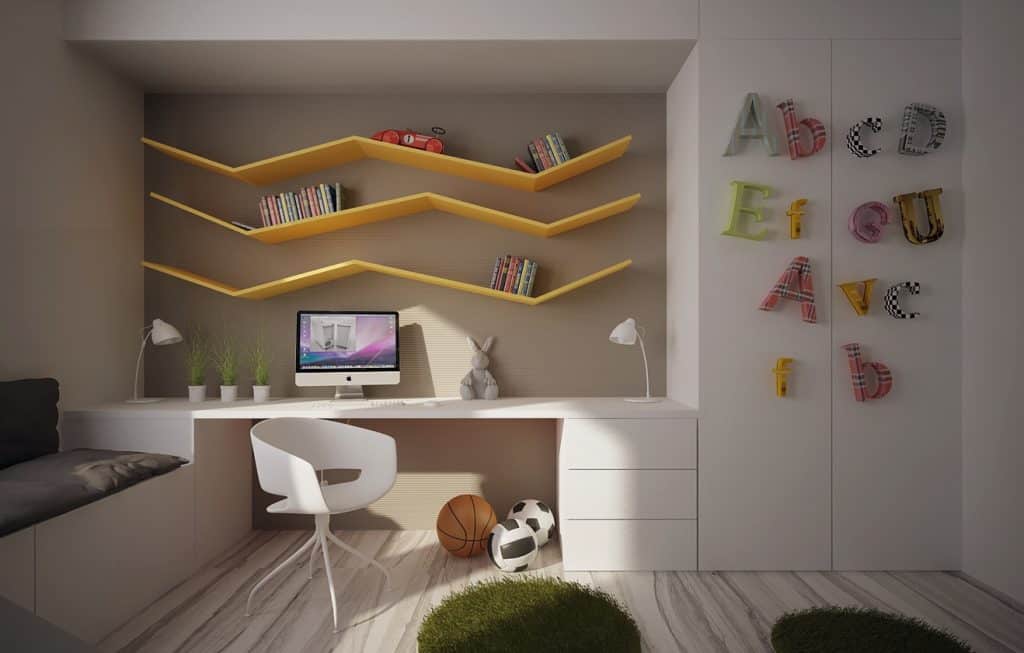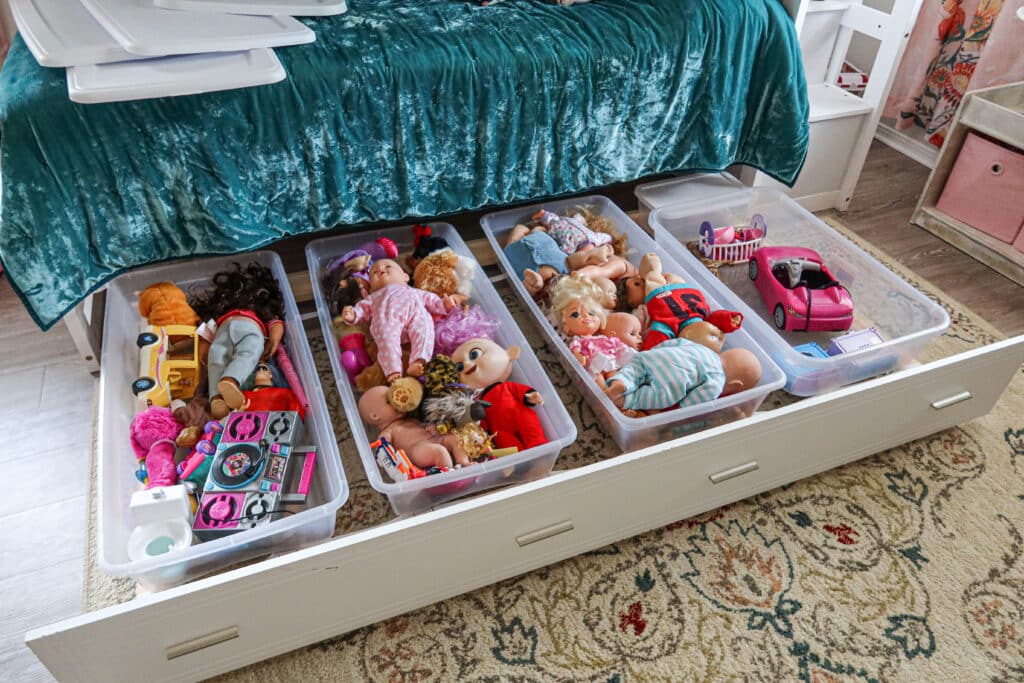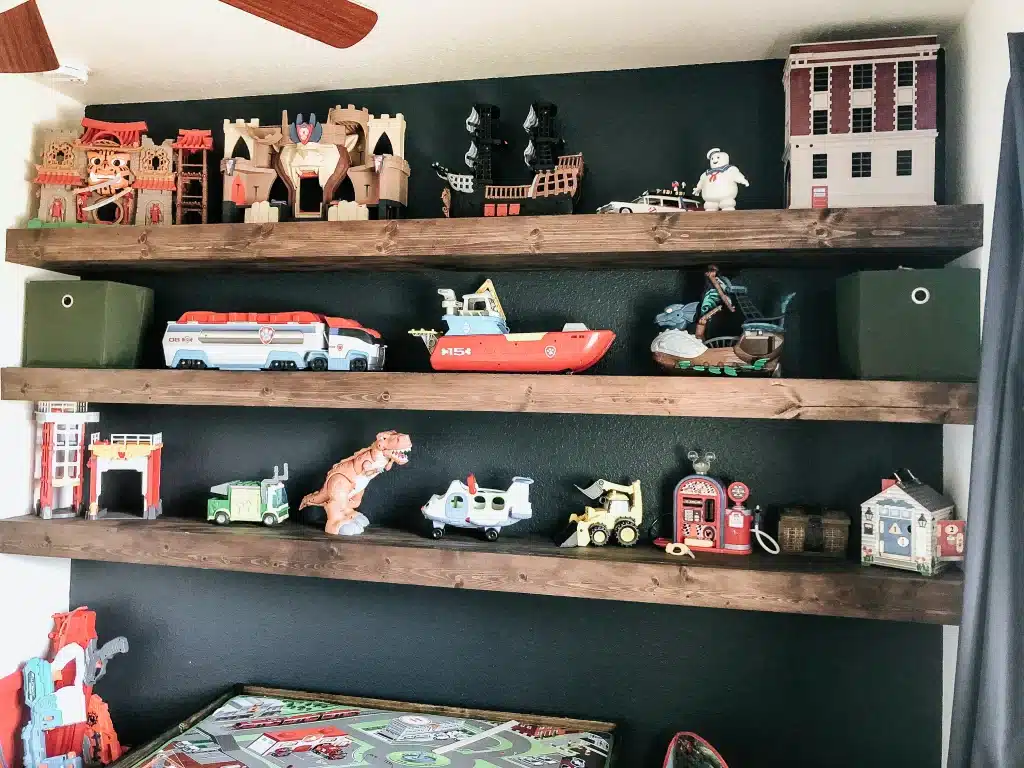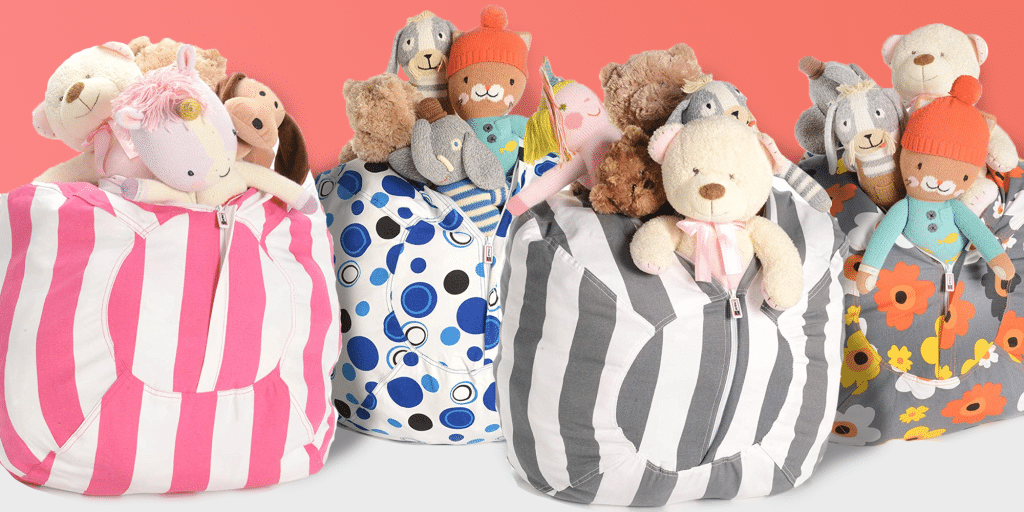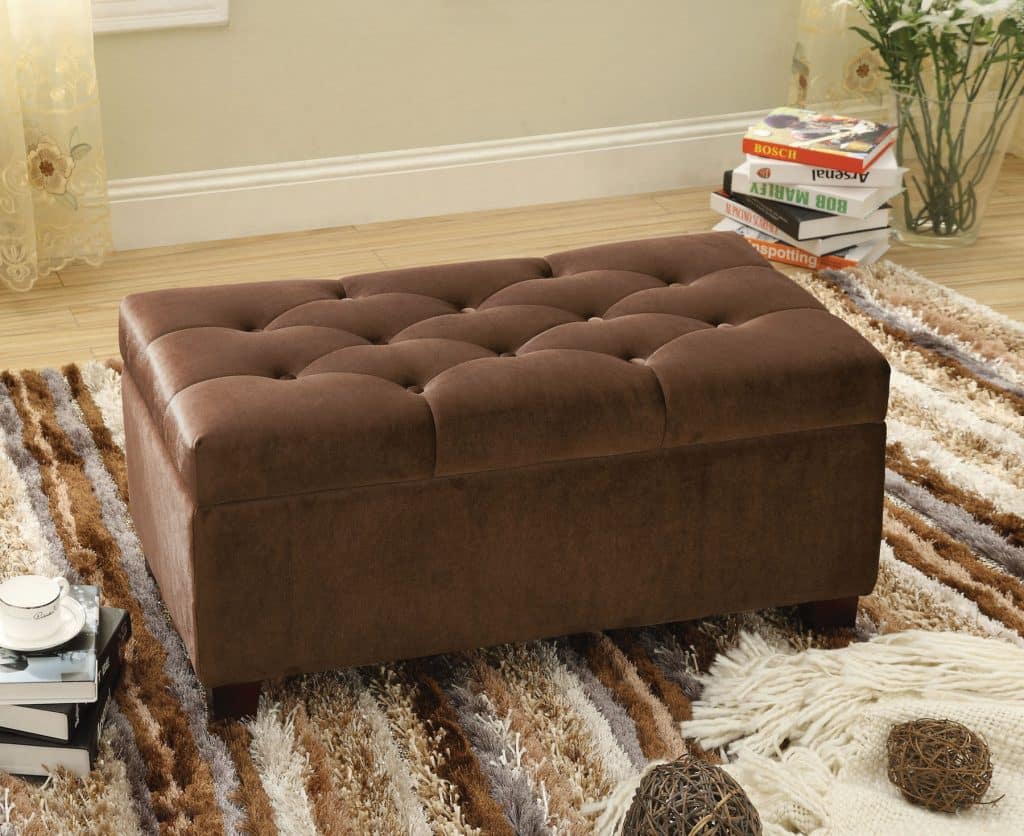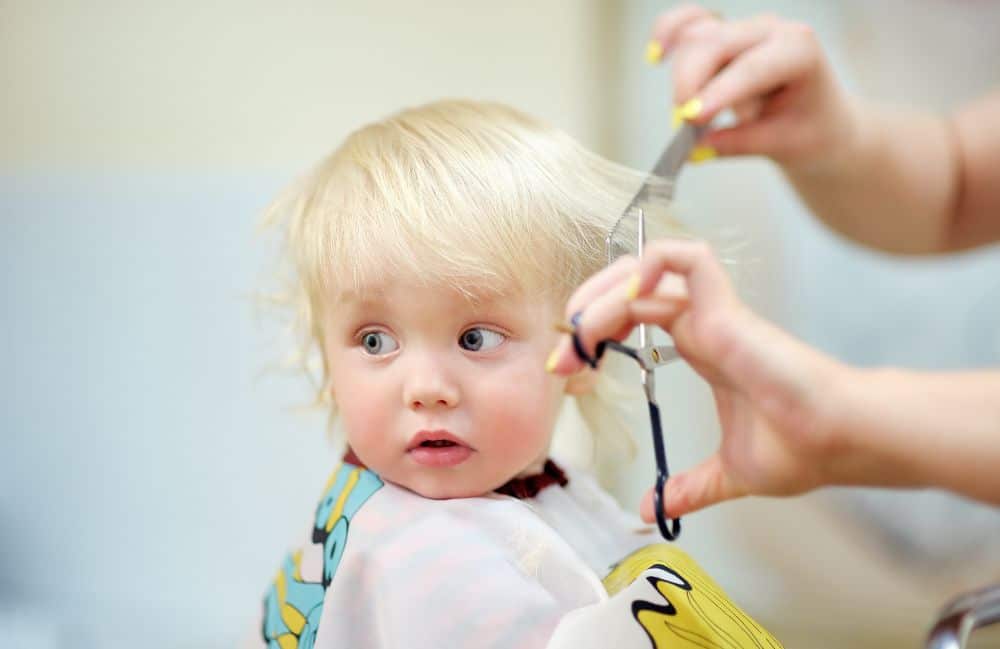Are you excited to welcome to the fascinating world of playrooms where the tiny explorer’s wild imagination can run free among a sea of toys? We have got you some best and most creative playroom storage ideas that will help you to keep your kid’s playroom clutter-free.
Prepare to set out on an exciting adventure for an organization where the cubbies lure you into their lovely domains, floating shelves unveil their mystical abilities, and hidden storage ottomans promise delights beyond their wildest dreams. All the options covered are highly adaptable and functional. You must give them a try on.
Let’s add a dash of magic to your kid’s playroom and wave goodbye to the mess as you enter the world of engaging and exciting storage options that will spark the curiosity of any young explorer!
1. Open Shelving Units
Playroom toys can be arranged using open shelving systems. First, sort and remove your belongings. Choose durable, kid-friendly, and appropriate-sized open-shelf units for the playroom. To tailor the storage space to your needs, think about units with movable shelves. Organize the toys into categories and group them alongside related items. You may, for instance, have distinct places for art materials, puzzles, dolls, action figures, and building blocks. To organize the toys under each category, place baskets or containers on the shelf.
Create a visually appealing and practical arrangement for toys on the shelf. Keep the toys kids use the most on lower shelves so they can easily reach out to them. At the same time, a taller shelf is a good place to showcase larger toys or decorative things. With your children, figure out a daily or weekly housekeeping time. Play some music while you clean up together to make it more enjoyable. Kids can readily identify the placement of each toy with this playroom storage, helping them learn to put toys away after use.
2. Cubbies
A world of neat delights is available in cubbies. Since each toy has its kingdom in this playroom storage, it can no longer travel freely. As if by magic, cubbies make toys accessible. Children are empowered to explore and create freely because small hands may easily access their favorite playthings. You can now leave the tedious cleanup mission behind! Cleaning up is now a fun experience, thanks to cubbies.
Toys must be put back in their designated cubbies, which will be challenging for kids to do, turning it into a fun game. For the imagination to run wild, this playroom storage idea provides a tiny canvas. Little ones’ imaginative brains can create new worlds and wonderful stories when everything is in its proper place.
3. Toy Hammocks and Nets
Your playroom can be decluttered or organized by hanging toy hammocks and nets from the walls or corners. This creative playroom storage option is both entertaining and useful. They are often composed of netting material that stretches, resembling a hammock or fishing net, and are intended to hold plush toys, stuffed animals, and soft toys. The vertical wall space, which is often underused in playrooms, can be made use of with the help of toy hammocks and nets. A neat and more organized atmosphere is created by hanging them up high, which frees up valuable floor space and prevents toys from getting lost.
Being buried at the bottom of bins and boxes makes it difficult to put the soft toys there. Every toy is reachable and visible with this playroom storage. Children can quickly locate the toy they wish to use and conveniently put it away when they are playing. This beautiful addition can elevate the interior design of your kid’s playroom. You can pick the one that matches the theme or color scheme of the playroom because they are available in a variety of colors and styles.
4. Wall Mounted Shelves
A practical and room-saving storage option is provided by wall-mounted shelves, which are shelves that are nailed or screwed into the playroom’s walls. Depending on the requirements of the playroom and the accessibility of the children, they are available in a variety of materials, sizes, and design patterns and can be erected at various heights. Vertical space can be made use of with this playroom storage idea, maximizing storage without consuming valuable floor space. This is especially helpful in tiny, cramped playrooms. Flexible arrangements are possible with wall-mounted shelves.
To create a unique configuration that meets your playroom’s demands and enables future alterations, you can place them at various heights and positions. With the right equipment, installing the majority of wall-mounted shelves is simple. They are, therefore, a practical and accessible playroom storage option. They offer convenient, well-organized storage, free up floor space, and foster a welcoming atmosphere that inspires kids to play and explore. The playroom is transformed into a useful, orderly, and enjoyable environment for young explorers to see out on their imagined travels when shelves are mounted to the walls.
5. Under-The-Bed
De-cluttering the toys and maintaining a clean playroom are both possible with under-the-bed storage. Creating additional storage without taking up additional floor space is possible with the help of this playroom storage idea, which is a useful and effective way to make use of an area that would otherwise be useless. Under-the-bed storage makes the most of every inch of the playroom, which is frequently a small place. To make it simple to slide out and retrieve toys, several under-the-bed storage alternatives have wheels or handles.
Kids don’t require assistance to fetch and stow away their toys. Playroom space is extended by under-the-bed storage, which also helps keep the toys organized. The area under the bed can be used as a reading nook or additional play surface for children. How about making a game for the youngsters to store their toys beneath the bed when playtime is finished to teach them to clean their playroom? This will indeed instill a feeling of accountability and organization from a young age.
6. Rolling Carts
Moving around the playroom is made simple with the help of rolling carts which are mobile storage containers with wheels. Usually having several shelves, drawers, or compartments, they offer flexible storage options for toys, art supplies, books, and other items. Playrooms can benefit from the practicality and adaptability of rolling carts which come in a variety of sizes, materials, and styles. This playroom storage idea is easy to upkeep and maintain. All you need to do is regularly wipe off the surfaces to keep them dust and spill-free.
Toys that are not being used right away can be temporarily stored on rolling carts if you rotate your toys to make your playtime interesting. If you want to introduce new toys, just roll the cart to storage space and bring it back. Make a distinct station for arts and crafts with this playroom storage idea. To encourage kids to participate in creative activities, keep coloring books, drawing paper, and painting essentials organized. They spruce up the playroom with some organization and adaptability and transform it into a fun and useful place for kids to go on their imaginary excursions.
7. Labelled Containers
Another idea to keep your playroom decluttered is by using labeled containers. To begin with, sort out all the toys and possessions in the playroom. Building blocks, art supplies, puzzles, dolls, and other goods can all be categorized by grouping comparable items. For each type of thing, select appropriate containers. It’s best to use clear plastic containers so children can easily see what’s inside. Toys should be kept in durable containers that are right in size.
Create vibrant and entertaining labels and place them on each container. Determine the location of each container now. For every type of toy, designate a specific shelf, cubby, or space. With this, kids will find and keep back the toys with ease. Be ready to expand the labels or modify the current ones as the collection of toys increases. To keep a playroom organized, flexibility is essential. Children can easily focus on playing, exploring, and making up stories when the playroom is more organized.
8. Floating Shelves
Wall-mounted shelves that have no obvious brackets or supports give the impression that they float on the wall and are called floating shelves. They have an elegant and clean appearance because the wall mounting hardware is concealed. For a fashionable and useful option for the playroom, consider floating shelves which comes in a variety of size, material, and patterns. With this playroom storage idea, you can organize the room and make it more aesthetically pleasing, which will promote play, imagination, and exploration. Clean-up time is made more fun and easy with the well-organized display and easy accessibility of toys.
With this playroom storage, you can add a touch of class and order to the fantastical world of kids. Since these shelves are adaptable, they can be changed as the kids get older and demand a playroom change. It is simple to rearrange the shelves or swap out the toys for more suitable products. Set the shelves to take advantage of the wall space and arrangement of your child’s playroom. You can construct one-of-a-kind configurations that enhance the interior decorations of the space and offer the best storage.
9. Bean Bags with Storage
In addition to giving the youngsters a practical and pleasant seating choice, bean bags with storage can be immensely helpful in clearing out the playroom. There are built-in storage spaces in these bean bags which are normally found in the base or sides of the bean bag. Storage-equipped bean bags do two tasks with just one item. This playroom storage is portable and can be easily moved around. It is useful to have toys close by when playing because you may put them in various locations.
Smaller playrooms or areas where you need to maximize the storage without taking up the additional floor space are perfect for these storage bean bags. A lively element is added to the room with this playroom storage idea which generally has vibrant and enjoyable designs. They can add to a lively and welcoming atmosphere while also enhancing the overall concept of the room.
10. Bookshelf Storage with Cabinets
Another creative playroom storage idea you must try your hands on! Think about combining the regular bookshelf’s practicality with the advantages of closed cabinets or drawers. This will create bookshelf storage with cabinets. For exhibiting books, toys, or ornamental goods, these units often have open shelves. Meanwhile, the cabinets and drawers offer converted storage space. They provide an adaptable and useful storage option for the playroom because of their wide range of designs, sizes, and configurations. You may make the playroom feel more organized and balanced by combining bookshelf storage with cabinets.
While cabinets hide clutter and offer a variety of storage options, open shelves offer a location for exhibition and easy access to commonly used things. The playroom seems cleaner and less chaotic, thanks to the hidden toys and possessions inside the cabinets. By doing so, you can keep the area neat and pleasant to the eye. Make sure your playroom storage comes with rounded corners and child-safe features. By combining the elements, the playroom becomes a practical and engaging space for kids to learn, play and explore. This fosters organization and encourages cleanliness.
11. Hidden Storage Ottoman
Hidden storage ottoman refers to footstools or ottomans that include a secret storage area inside. They have a lid that can be removed or hinged, revealing a compartment for storing toys, pillows, blankets, or other items. These are practical and adaptable additions to decluttering the playroom. This playroom storage comes in an array of sizes, styles, and patterns. With their dual function as a seating alternative and a convert storage option, these ottomans accomplish two tasks.
While keeping the toys neatly stowed away, they provide a space for the kids to sit, read or play. You may design a practical, organized place that promotes play and creativity in the playroom by including these hidden storage ottomans. Kids will have more room to explore and go on imaginary adventures because their toys and belongings are properly stored away. These storage ottomans are portable and can be moved around the playroom easily. Ottomans with hidden storage offer a smooth way of decluttering the playroom while also bringing a touch of coziness and usefulness to the area.
Summing It Up
All in all, keeping order may seem impossible in the colorful world of playrooms where creativity and fun go hand in hand. But you need not worry about the same anymore! We have come across some amazing playroom storage ideas that will surely help you to declutter your playroom and keep it organized. Every nook is filled with happiness and order thanks to the elaborate spell that toy hammocks, hidden storage ottomans, and rolling carts have weaved.
In an organized universe where dreams come true, and stories are told, the balance of order and imagination creates the ideal setting for many adventures. May the best playroom storage suggestions never stop inspiring us, helping us to maintain our playrooms neat and attractive while nourishing the limitless potential of every little explorer.
Happy playtime, little munchkins!



